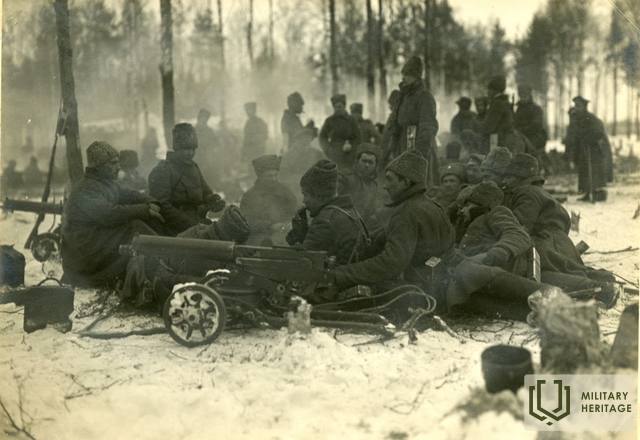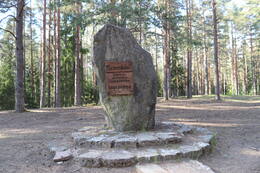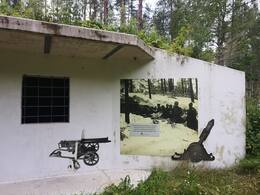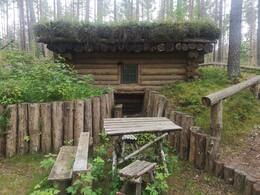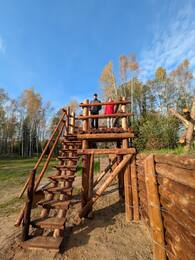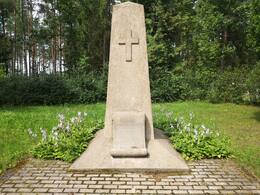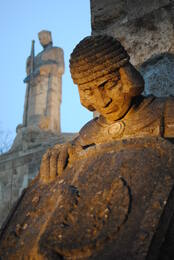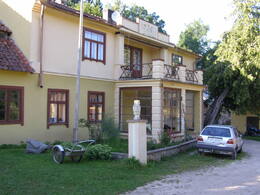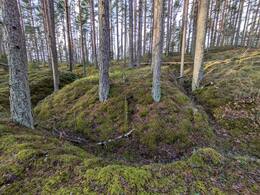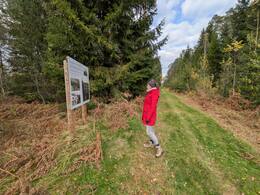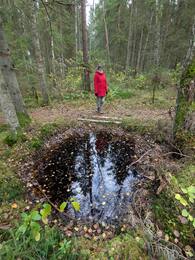Christmas Battles I World War I
The Christmas Battles have been recorded in Latvian history for all time as a tragic and at the same time heroic story. On January 5, 1917, the Russian 12th Army began its offensive on the Riga Front, officially called the “Jelgava Operation”. According to the old style or Julian calendar, the offensive began on December 23, that is, on Christmas Eve. Therefore, these battles, in which all Latvian rifle regiments participated together for the first time, were called the “Christmas Battles”. The Christmas Battles and the January Battles that followed them were the most tragic and at the same time one of the most heroic pages in the history of the Latvian riflemen.
The Russian army planned a major attack on the German Imperial Army, in which the Latvian riflemen were used as the main strike. The command of the 12th Army intended to break the German front in several places in a wide area from the left bank of the Lielupe River to the Jelgava highway with sudden attacks without prior artillery preparation. The attack took place in a swampy area between Lake Babīte and Olaini, which was called Tīreļpurva. Russia had set a goal of liberating Jelgava, and in case of success, all of Semigallia and Courland.
On the attack front, the Russian army gathered its forces, ensuring an advantage: a total of almost 100,000 Russian army soldiers against 20,000 German army soldiers. The attack was to take place in 8 places, of which 2 breakthroughs were to be carried out by Latvian rifle regiments, divided into two brigades. Both Latvian brigades had been preparing for the attack for a long time. The riflemen were carefully trained to overcome barbed wire fences and capture enemy fortifications. The mood of the riflemen was very good, everyone hoped for the early liberation of Semigallia and Courland.
The supply and command of the attack were unfortunately poorly planned and implemented, so the superiority of manpower did not help. The battle took place with attacks and counterattacks. The 2nd Latvian Rifle Brigade had successfully broken through the first line of German fortifications, occupying the southern part of Tīreļpurvas. For two days in -36°C, the riflemen held the occupied territory, but on January 7, the attack turned north, to the German-fortified Ložmetējkalns, which they occupied on the same day. The next day, January 8, the Latvian riflemen repelled several fierce German counterattacks, the aim of which was to regain previously lost positions. The capture of Ložmetējkalns by the Germans became the greatest success of the Christmas battles. Unfortunately, the Russian leadership did not use the capture of Ložmetējkalns to develop an attack on Kalnciems, which could have been occupied on the same day, before the Germans had time to consolidate and bring in reserves.
The Christmas Battles became the most famous and legendary battles of the Latvian Riflemen. The Latvian Riflemen managed to do what no Russian unit on the Riga Front had been able to do – break through the German fortifications and occupy an area of approximately 30 square kilometers. It was the first time that all Latvian Riflemen fought together shoulder to shoulder.
During the Christmas battles, both the Russian units and the Latvians had suffered very heavy losses. The losses of the 12th Army reached 19,000 soldiers. The Latvian regiments lost 5,364 riflemen from January 5 to 11, of whom 874 were killed and about 400 were missing. The gains from the battles were not great. The heavy losses strongly undermined the loyalty of the Latvians to the authorities of the Russian Empire and marked a turning point in the history of both the riflemen and Latvia.
More information sources
1. Blizzard of Souls. Digital Museum. Available: https://www.dveseluputenis.lv/lv/laika-skala/notikums/85/ziemassvetku-kauju-sakums/ [accessed: 05.05.2021.].
2. Latvian Radio 2 Latvian Centennial Story Articles “Christmas Battles”, 2017. Available: https://lr2.lsm.lv/lv/raksts/latvijas-simtgades-stastu-raksti/ziemassvetku-kaujas.a97478/?highlight=str%C4%93lnieki [accessed: 05.05.2021.].
3. lsm.lv program “Vēstures ķilis” episode “Conversation with historian Jānis Šiliņš about the Christmas battles and riflemen”, 2017. Available: https://naba.lsm.lv/lv/raksts/vestures-kilis/saruna-ar-vesturnieku-jani-silinu-par-ziemassvetku-kaujam-un-str.a79704/?highlight=str%C4%93lnieki [viewed: 05.05.2021.].
Related timeline
Related objects
Ložmetējkalns (Machine Gun Hill) in Tīreļpurvs Bog
Ložmetējkalns is located in Valgunde Rural Territory, Jelgava Municipality, close to the A9 motorway. It is the site of a World War I battle and the only cultural heritage conservation site of national importance in Latvia. Ložmetējkalns is located on Garā Kāpa Dune, which is a part of the Nordeķi-Kalnciems dune ridge. The name originated at a time when it was the site of impregnable fortifications of the German Army, which was defended by heavy machine-gun fire.
The Christmas Battles are one of the best-known and most dramatic events of World War I in the history of Latvia. In 1917, the units of Latvian Riflemen and Siberian riflemen of the Russian Army attacked and took Ložmetējkalns, capturing at least 600 enemy troops and valuable trophies. The riflemen believed that they were the ones who deserved the honour of captors of the highlands.
The area around Ložmetējkalns Hill is home to commemorative marks and other evidence of the battles that took place here. Every year, in January, memorial events are held in the surroundings of Ložmetējkalns to remember the Christmas Battles. Nowadays, Ložmetējkalns has become a symbol and a memorial site dedicated to the heroism of Latvian Riflemen. A 27-metre-high observation tower offers panoramic views of the site of Christmas Battles.
Latvian soldiers’ former medical warehouse
Located in Babīte district, near the Antiņi soldiers' cemetery and the renovated trenches.
During World War I, the defensive positions of the Russian Empire's army were located in this area from 1915. In 1917, during the Christmas battles, the headquarters of the 5th Zemgale Latvian Rifle Regiment and a hospital with a medicine warehouse were located near the Antiņi house, which was headed by the prominent Latvian military doctor Pēteris Snīķeris.
During the Christmas battles, Latvian riflemen attacked German army units in particularly harsh and unfavorable conditions. The injuries sustained in the battles were of various kinds - gunshot wounds, contusions and traumas, as well as frostbite. Timely medical assistance had to be provided to thousands of Latvian soldiers. It was organized so that the wounded could receive care as quickly as possible. Unarmed paramedics operated on the battlefield, providing first aid and taking the wounded out of dangerous places. Dressing points were set up near the battlefields, where care was continued and triage was carried out. More seriously wounded soldiers were evacuated to infirmaries or hospitals by carts and cars. Cemeteries were established near the infirmaries, where those who died from injuries were buried.
Today, you can visit the old medicine warehouse. Nearby is the Antiņi soldiers' cemetery, as well as reconstructed World War I trenches and dugouts. The environment is suitable for walks in the forest, revealing vivid evidence of military heritage.
Latvian riflemen positions and trenches in Tīreļi
Latvian Riflemen dugouts and trenches in Tīreļi are located in Babīte parish, Mārupe municipality, in the vicinity of the Antiņi Latvian Riflemen Cemetery and the former medicine warehouse. During World War I this was the defensive position of Latvian Riflemen of the Russian Imperial Army. A complex of trenches and surface dugouts was built in the sandy hills. Trench or positional warfare is the best way to accurately describe World War I and emphasise the importance of fortifications. They were based on the research of military engineers and adapted to the environment and the development of new weapons. The everyday life of a soldier is a continuous improvement of defensive fortifications. Sometimes soldiers would give the dugouts names that reminded them of their homes and would help to forget about the reality of the war. Trench lines were complex defensive systems that were hard for the enemy to take. With the development of weapons these defences became even more sophisticated. The roofs of dugouts were reinforced to withstand artillery shells. Trenches were made in changing patterns and directions so that explosions would cause as little damage as possible. Movement passages had pockets that were used as short-term hiding spots during artillery fire, because they protected soldiers from shrapnel and rubble. Today part of the fortification has been restored and you can visit 3 restored dugouts and a 100 m long section of the trenches.
Christmas Battle Museum
The museum is located in “Mangali” house, Valgunde Rural Territory, Jelgava Municipality, and it is a branch of the Latvian War Museum. It was unveiled in 2005 at the site of the Christmas Battles that occurred during World War I. Unique World War I fortifications still remain at the battle sites. The open-air exhibition of the Christmas Battle Museum reconstructs a section of the fortification system – the trench shelter and part of the first line of German defence – the “German rampart”, which is the only object of this kind in the Baltic states.
The Christmas Battles are one of the best known and most dramatic events of World War I in Latvia. They are an event of special importance in Latvian military and cultural history. Intense fighting took place for six days, leading to heavy casualties. The battles are mainly associated with the attack of Latvian Riflemen against the German Army units, which took place in particularly severe and unfavourable winter conditions. This is an unprecedented case of a major combat operation launched without artillery support.
Today, the museum artefacts found at the sites of the battle are on display. The indoor exhibition is open at certain times, while the exhibition of outdoor fortifications is open every day. Tourist routes and nature trails have been created in the surrounding area.
Christmas battles memorial at Antinu Brethren Cemetery
Located in Babīte district, on the side of the road near the former Antiņi house and the old medicine warehouse.
The Antiņi or Tīreļi Soldiers' Cemetery was established during World War I. The area was home to defensive positions of the Russian Empire Army. In 1917, during the Christmas Battles, the headquarters of the 5th Zemgale Latvian Rifle Regiment, a hospital with a medicine warehouse, were located nearby.
In 1917, on the night of January 5-6, under the illumination of eight huge bonfires, 105 fighters of the 5th Semigallian Latvian Rifle Regiment were buried with military honors. They fell in battles against the German army or died of wounds. The burial ceremony was led by the regiment's commander, Jukums Vācietis. In later years, soldiers from other units of the Russian army were also buried in the cemetery. In 1925, a monument by architect Eižens Laube was unveiled in the cemetery, and the territory was landscaped. Information about 3,800 soldiers buried in the cemetery is found in many places, but it should be considered unlikely and unverified.
Brothers' Cemetery in Riga
Riga Brothers’ Cemetery is located in the northern district of Riga. The cemetery extends over an area of 9 ha and is the most outstanding and significant memorial ensemble in Latvia dedicated to the fallen Latvian soldiers. About 3,000 soldiers are buried here. The Brothers’ Cemetery was created during World War I after the first three Latvian Riflemen, who fell in Tīreļpurvs in the battle against the German Army, were buried here. Later Latvian soldiers who had died in other battles and wars would also be buried in the Brothers’ Cemetery. The memorial is based on the design of the sculptor Kārlis Zāle, and is the first memorial ensemble in Europe with such landscape, architecture and sculptural value. It uses elements typical to the Latvian landscape, traditional farmsteads, Latvian folklore and history that praise the characteristics of soldiers and tell the story of the way of the soldier. The memorial was unveiled in 1936 and it has three parts: ‘The Road of Though’ which is a 250 m long alley, ‘Terrace of Heroes’ with the Altar of the Sacred Flame and ensemble the Sacred Oak Grove, and the burial ground with the Latvian wall and a memorial of a mother with her fallen sons.
General L. Bolstein Museum
Located 17 km from Kandava in Pūcesdzirnavas, Matkule parish.
The memorial room of Latvian Army General Ludvigs Bolšteins has been created in the Pūces mill territory, in a rest house. The property was once leased by the Bolšteins family. Since the end of the 19th century, a sawmill, a grain mill, and sheep wool processing were operating here.
Ludvigs Bolšteins was one of the most experienced Latvian soldiers, who actively participated in the creation of the Latvian Riflemen units. He participated in the War of Independence and the creation of the Latvian state. At the beginning of World War II, Ludvigs Bolšteins was an example of demonstrating complete non-cooperation with the Soviet occupation regime. One of the two highest-ranking officers of the Latvian Army who committed suicide because he did not want to cooperate with the Soviet occupation authorities. A vivid source of history is the general's death letters, which allow us to better understand the personality and the situation in which the Latvian state was at the beginning of World War II. The letters read: "To our superiors. We, Latvians, built a new, stately building - our state. A foreign power wants to force us to demolish it ourselves. I cannot participate." In turn, the text of another letter was addressed to his mother: "Mother, forgive me, I could not do otherwise."
By registering in advance, you can visit the memorial room and see an exhibition dedicated to the general.
Nordeķi – Kalnciemas dune ridge
The approximately 30 km long dune ridge, which can be traced in nature from Iļģuciems (with minor interruptions) to Tīreļi today, is one of the most impressive landforms of the Seaside Lowlands, which is rarely perceived as a single natural formation. The dune was formed on the shores of one of the last Baltic glacial lakes, as the waters of the Baltic glacial lake receded. The dune ridge consists of two parallel 50–100 m wide dune belts. They are usually 6–10 m high, but their highest points reach 16–19 m above sea level. In the vicinity of Kleisti, Imanta and Beberbeķi, the beautiful pine forests covering the dunes are a popular place for walking, recreation and sports, and in winter - cross-country skiing. The part of the dune in the vicinity of Lāčupīte is associated with the events of the Bermontiades. On the dune in Pārdaugava is the Lāčupe or Lācaras cemetery . Between Pinkie and Babīte, the Beberbeķi Nature Park has been established to preserve the dunes. The western part of the Nordeķi-Kalnciemas dune ridge, approximately 10 km long, is called the Long Dune . Near the Long Dune (south of Trenči) is the Antiņi Brothers Cemetery , the Latvian Riflemen's Hospital medicine warehouse , and the renovated Latvian Riflemen's dugouts . South of the Long Dune is a massif of swampy forests and marshes, including Rāvājs and Maztīrelis . Opposite Maztīrelis is Ložmetējkalns with a viewing tower and a resting place and the so-called German rampart section . Even further west, near the Long Dune are the Latvian Riflemen Brothers Cemetery and the Piķi Brothers Cemetery. With greater or lesser interruptions, trenches are visible almost along the entire Nordeķi-Kalnciemas dune ridge. In the southwestern part of the Long Dune – in the swampy forests that adjoin it from the south, bomb craters from the First World War are visible. Along the entire length of the Long Dune (south of it), small forest paths run, suitable for walks and longer hikes – a great opportunity to explore the sites of the First World War battles.
Krači Mountains Monument
The Krāči Hills are one of the largest coastal dunes of the Litorina Sea. Its highest point is 29 m above sea level and 26 m above the surrounding plains. The Litorina Sea is said to be the predecessor of the Baltic Sea, which existed approximately 7,000 to 5,000 years ago.
The 6th Special Brigade of the 12th Russian Army launched the attack from the Krāči Hills during the Christmas Battles, with the task of breaking through the German front from the Great Tīreļi Swamp to the Lielupe River. During the month-long battles, the Russian army gained an area of 25 square kilometers, but the losses were enormous – 45 thousand fallen, wounded and missing soldiers. The losses of the Latvian riflemen were 9 thousand fallen, wounded and missing soldiers. During the Christmas Battles, the Latvian riflemen gained immense fame as heroic and brilliant soldiers, paying a very high price for it – their lives.
A monument has been erected in memory of those who fell in battle. Every year on November 11, Lāčplēsis Day, and on November 18, the anniversary of the proclamation of the Latvian state, candles are lit at this place in memory of the fallen heroes.
The protected nature area "Krāči Mountains" as a dune mound of the Litorina period
Hiking route (educational trail) near the Christmas Battle Museum
The approximately 7 km long hiking route – the educational trail can be started at the Christmas Battle Museum, where there is a car park and toilets. It is worth taking a map or a photocopy of it with you. The trail is marked along its entire length. It can be walked in different seasons – in summer, autumn, when the leaves are turning color, or in spring, when the primroses and other spring flowers are blooming. It should be taken into account that there are poor mobile communications in the vicinity of the trail. The difficulty level of the trail is easy, but you should take into account the time needed to walk it and get to know all the objects. Surface – forest roads, trails, natural surface, gravel roads. Starting from the Mangaļi Houses in a clockwise direction, it is worth walking the trail not along the gravel road, but along the German Rampart section, which extends the route by about half a kilometer. There are wooden bridges over the ditches. Be careful, because in wet weather they can be slippery.
There are 18 stops along the route, which are equipped with information boards:
- The first line of fortifications of the Russian army – the so-called “Russian Rampart”;
- 3. The starting positions of the Courland Latvian Riflemen Regiment for the Christmas Battles attack;
- Headquarters of the United Latvian Riflemen Division at the beginning of the Christmas battles;
- Russian Army artillery positions;
- 4. Exit positions of the Vidzeme Latvian Riflemen Regiment for the Christmas Battles attack;
- 1. Daugavgrīva Latvian Riflemen Regiment's starting positions for the Christmas Battles attack;
- Neutral zone;
- Barbed wire fences;
- The first line of fortifications of the German army – the so-called “German Wall”;
- A water intake point set up by German army soldiers;
- Artillery shell explosion pits;
- The German army's rear fortification system;
- Viewable positions, bunkers, trenches, bomb craters, memorial stones, etc.
Artillery shell explosion pits
The most convenient way to see and find these objects is to follow a hiking route or educational trail, which is 7 km long. It starts at the "Mangaļi House". If you follow the route clockwise, the artillery shell pits will be at the end of the route and vice versa. They are located close to the "Mangaļi House", so you can go to them and come back if you don't want to walk the entire long route.
"During the battle, an artillery shell exploded and dug a hole in the ground, and such wartime evidence still remains at the sites of the Christmas battles. The size of the hole was determined by the size or caliber of the shell fired. The most commonly used shell left a hole 1.5 m in diameter and 0.7 m deep, while a howitzer shell left a hole 3.5 m in diameter and 1.5 m deep." We can read such a text on an information stand.
The craters left by the shells are also visible elsewhere in the wider area. They are clearly visible on the LIDAR map.
Related stories
A diary entry about the moment when soldiers learn about preparations for the Christmas battles.
The Latvian riflemen and their officers were informed about the beginning of the battle at the last moment. The non-commissioned officer of the 5th Zemgale Latvian Riflemen Regiment, Rūdolfs Ivanovs, described in his diary the last evening before the start of the battle. A short, but vivid and authentic text that shows a very important moment for a soldier – learning about the day of the battle.
Building defensive positions.
The description examines the problems of battlefield fortification in general. It is based on the experience of World War I and the situation when it was necessary to organize extensive work on the creation of fortifications.
A commemorative badge dedicated to Admiral Makarov was found in the yard
A small military relic can tell a vast historical story. And although the badge represents events that took place during the Russo-Japanese War, it also shows the colorful military history and the involvement of our Latvian Riflemen in other military conflicts, both before and after the Wars of Independence.




